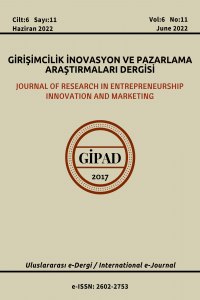Müşteri İhtiyaç Analizi: İskandinav Kültürünün PVC Masa Örtüsü Desenlerine Yansıması Üzerine Bir Araştırma
Araştırmanın amacı, İskandinav kültürünün PVC masa örtüsünde uyarlanma sürecini analiz ederek, işletmeye ve müşteriye ne şekilde yarar sağladığını ortaya koymaktır. Müşterilerin ihtiyaç ve beklentilerini karşılama amacı ile yapılan desenlerin üretim süreci vaka analizi ile açıklanmaktadır. Araştırmanın sonuçları, müşteriye yapılan anket ve işletme çalışanları ile yapılan görüşmeler ile desteklenmektedir. Araştırmanın sonuçlarına göre, işletmenin toplam satış miktarının %4’ünü oluşturan İskandinav ülkelerine satış miktarı %8’e ulaşmıştır. O bölgedeki mevcut müşterilere ‘Müşteri Memnuniyeti ve Sadakati’ anketi uygulanmış, anket sonuçları koleksiyon öncesi (2017) ve koleksiyon sonrası (2018) olarak karşılaştırmalı analiz edilmiştir. Anket sonuçlarına göre 2018 yılı memnuniyet oranının 2017 yılına göre %30 oranında, sadakat oranının %23 oranında arttığı görülmüştür. Ayrıca 1 adet yeni pazar, 2 adet yeni müşteri firma bünyesine katılmıştır. Bununla birlikte işletme, hedef alınan pazarda pazar payını artırmış, yeni müşteriler bulmuştur. İşletmenin sürekli değişim gösteren trendlere uyum göstermesi, sektördeki rakiplerine göre güçlü yönünü ortaya koyması araştırmanın sonuçları ile paralellik göstermiştir.
Anahtar Kelimeler:
İskandinav Kültürü, ev tekstili, PVC masa örtüsü, desen
Customer Needs Analysis: A Research of the Reflection of Scandinavian Culture on PVC Tablecloth Designs
The aim of the research is to analyse the adaptation process of the Scandinavian culture on PVC tablecloths and to show the benefits of the business and customer. The production process of the designs made to meet the needs and expectations of the customers is explained with case analysis. The results of the research are supported by questionnaire conducted to the customer and interviews with employees. According to the results of the research, the amount of sales to Scandinavian countries, which constitute 4% of the total sales of the firm, reached 8%. ‘Customer Satisfaction and Loyalty’ questionnaire was applied to the existing customers in the region, and the results of the survey were analysed comparatively between pre-collection (2017) and post-collection (2018). According to the results of the questionnaire, the satisfaction rate of 2018 increased by 30% and the loyalty rate increased by 23% compared to 2017. In addition, 1 new market and 2 new customers incorporated. In addition, the company increased its market share in the targeted market and found new customers. Adjusting to the ever-changing trends and revealing company’s strengths compared to its competitors in the sector show parallelism with the results of the research.
Keywords:
Scandinavian Culture, home textile, PVC tablecloth, design,
___
- Aytekin, Ş. (2019). Estetik ve İşlevsel: Evlerde İskandinav Stili. Erişim yeri http://www.arcadium.com.tr/Blog/estetik-islevsel-evlerde-iskandinav-stili.
- Bright, K. & Cook, G. (2010). The Colour, light and contrast manual: Designing and managing inclusive built environments, Wiley-Blackwell, United Kingdom.
- Chernyshova, A.P. & Ishimova, E.S. (2013). Humanistic ideas in Scandinavian design. Modern Scientific Research and Their Practical Application, 21304:88-91.
- Csikszentmihalyi, M. & Rochberg-Halton, E. (1981). The Meaning of Things: Domestic Symbols and the Self. Cambridge University Press, Cambridge, MA.
- Demir, F. (2012). Ülke Orjininin Marka Kimliğine Yansıması: IKEA Örneği. İstanbul Üniversitesi İletişim Fakültesi Dergisi, (28):45-57.
- Donceani M. (2016). The Ornamentation of Traditional Folk Home Textiles in the Area of Moldavia. Lucrări Ştiinţifice, 59(2):327-330.
- Ersoy, A.F., Tokyürek, Ş., Arpacı, F. & Demirci A. (2007). Kadın Tüketicilerin Ev Tekstil Ürünlerini Kullanım Durumları, Tercih ve Sorunları. Gazi Üniversitesi Endüstriyel Sanatlar Eğitim Fakültesi Dergisi, (20):1-15.
- Koomsap, P. (2013). Design by customer: concept and applications. Journal of Intelligent Manufacturing, 24(2):295-311.
- Kotler, P. & Rath, G.A. (1997). Design: A Powerful but Neglected Strategic Tool. In Marketing and Design Management (edited by M. Bruce and R. Cooper), International Thomson Business Press, London, UK.
- Kuskowski, A. (2015). Scandinavian Art, Fun and Easy Art from Around the World. Super Simple Cultural Art Set, (2):1-32.
- Munch, A.V. (2014). Memories by measure? Mediating the home textiles of Georg Jensen Damask. Blucher Design Proceedings, 1(5):279-284.
- Nef. (2018). IKEA Kataloglarının Ötesindeki İskandinav Stiline Bakış. Erişim yeri https://www.nef.com.tr/blog/ikea-kataloglarinin-otesindeki-iskandinav-stiline-bakis
- Otyam, N.K. (2012). Doğayla İç İçe Yaşayan Ülke İsveç: Gözlemler-İzlenimler. Yapı, 9(1), 13-16.
- Öcal, M. (2012). The Role of Tradition and Everyday Life in Scandinavian Modern Design. (Yüksek Lisans Tezi), İzmir Yüksek Teknoloji Üniversitesi, Fen Bilimleri Enstitüsü, Endüstriyel Tasarım Anabilim Dalı.
- Pryczynska, E. & Anderwald, A. (2003). The Design Connotations of Clothing and Interior Fabrics in The Aesthetic and Application Aspects, Based on An Analysis of Recent Fashion Guidelines. Fibres and Textiles in Eastern Europe, 11(4):15-19.
- Ramsamy-Iranah, S. & Budhai, N. (2013). Developing A New Concept of Reversible Textile Furnishing. International Journal of Home Economics, 6(2): 286-304.
- Salkill, E. (2008). Easy Reversible Tablecloths You Make in Minutes. Retrieved from http://www.associatedcontent.com//article/583931/easy_reversible_tablecloths_you_make.html.
- Sharma, M. & Mishra, A. (2014). Kitchen Textile with Gandhara Motifs. IOSR Journal of Humanities and Social Science, 19(3):62-69.
- Sparke, P., Massey, A., Keeble, T. & Martin, B. (2009). Designing the Modern Interior, Berg, Oxford.
- Tam, K.Y. & Ho, S.Y. (2006). Understanding the Impact of Web Personalization on User Information Processing and Decision Outcomes. MIS Quarterly, 30(4): 865– 890.
- Wang, Y., Song, J. & Li, D. (2015). Application of Textiles with Plant Textures in Soft Decoration of Home Furnishing. Cross-Cultural Communication, 11(8): 93-98.
- Zhang, K., Ma, B., Dong, P., Tang, B. & Cai, H. (2010). Research on Producer Service Innovation in Home-Textile Industrial Cluster Based on Cloud Computing Platform. In Proceedings of 2010 IEEE International Conference on Service Operations and Logistics, and Informatics, pp. 155-160.
- Zhou, X.Q. (2011). Brief Discussion on Design of Soft Decorations in Modern Furnishing. Grand Stage, (4).
- Zhu, H. (2009). The Application of Decoration Skills in Modern Textile Products. In 2009 IEEE 10th International Conference on Computer-Aided Industrial Design & Conceptual Design, pp. 1705-1708.
- Yayın Aralığı: Yılda 2 Sayı
- Başlangıç: 2017
- Yayıncı: Mehmet MARANGOZ
